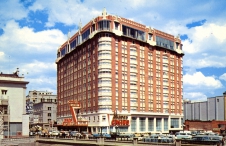Landmark Hotel
The off-Strip Landmark Hotel began as an unfinished attraction for a shopping center and became the last of six casinos owned by billionaire Howard Hughes. It would struggle to stay in business for decades until it was closed in 1990 and destroyed in 1995.
In 1960, Frank Carroll, a successful building contractor from Kansas City, bought land on Paradise Road and Convention Center Drive, across from the new Las Vegas Convention Center, several blocks east of the Las Vegas Strip. Carroll wanted to build a resort there, with a $3 million loan from the Appliance Buyers Credit Corporation, which supplied credit to consumers of Whirlpool brand washers and dryers.
Carroll's vision included a hotel-casino based on the style of the Hollywood Landmark Hotel, a lush establishment built in the mid-1950s in West Los Angeles that catered to celebrities. But Carroll's towering architectural design for his Landmark would come to resemble the Seattle Space Needle, built in 1962. The apex of the Landmark tower would also be compared to the "space age," saucer-like dome that fronted the neighboring convention center, which opened in 1959.
Carroll started building his hotel tower, proclaiming it would be the tallest structure in Nevada, at fifteen stories. But he soon found himself in a promotional "race" with downtown's Mint Hotel (which opened a twenty-six-story tower in 1965) over whose hotel would be the tallest. Carroll, determined to outdo all of Las Vegas, eventually adjusted his plans to extend his resort to thirty-one stories.
Carroll needed $10 million to build the kind of tower he wanted, and he could not find a lender. So to bide his time, he built a shopping center and a 120-unit apartment complex at the site and opened them just west of his uncompleted tower in 1961. The mall, called Landmark Plaza, included Ramsays, a department store. But Carroll's project came to a complete halt in 1962 when Appliance Buyers denied him further credit.
For years, the partially built tower stood vacant while Carroll attempted to raise money. He succeeded in 1966 when he received a $6 million loan from the Teamsters Union Central States Pension Fund. The union pension fund had been a conduit for cash since the 1950s for some Las Vegas casino builders who associated with organized crime. But Carroll was never accused of any such ties.
Carroll used the Teamsters money to resume construction. But the union loan amount still wasn't enough to finish it. Eccentric billionaire Howard Hughes stepped in to buy the unfinished hotel property from Carroll for only $17 million in late 1968. It was the final step in a Las Vegas casino-buying binge Hughes had started in 1967. Hughes spent several million more to finish Carroll's job, overseeing completion of the Landmark's upper floors and its distinctive top-floor glass cupola.
The shaft of the Landmark's tower would house many of the hotel's 525 rooms, while other rooms were built into a series of single-story buildings. The hotel's entrance was made of solid marble. The first floor housed a casino, a 500-seat showroom and some small shops. The hotel's western side had a sprawling, ground-level pool and waterfall with tropical landscaping, similar to that of the Hollywood Landmark.
The tower's large dome, topped with a revolving neon "L" sign, was the Landmark's true attraction. The three-story glass and metal dome included a Chinese restaurant and a steakhouse on the first floor, and a casino, lounge, and coffee shop on its second level. Its third floor was a nightclub with a panoramic view of Las Vegas and a dance floor for more than 200 people. An exterior glass elevator, facing the Strip, lifted visitors up the shaft to the dome.
In summer 1969, Kirk Kerkorian was readying his thirty-story International Hotel, considered the first Las Vegas megaresort, right across Paradise from the Landmark. Kerkorian's project, with 1,568 rooms, would be the world's largest hotel. Hughes, seeking to compete for the attention paid to the expansive International, determined to open the Landmark on July 1, 1969, and Kerkorian decided to debut the International the next day.
The Landmark was the only one of the six Las Vegas casinos that Hughes acquired before it had opened. Though he monitored even the smallest of details in the project, and had invested in it considerably to make it work, the Landmark was not a hit, and lost millions for Hughes in its first year. Hughes left Las Vegas for good in 1970. Later, he signed over the Landmark to former wife Jean Peters as part of their divorce agreement.
Compared to its casino neighbors, the Landmark suffered from a lack of high roller gamblers. Guests complained the rooms in the tower were too small. The hotel had a succession of unsuccessful owners in the 1970s and 1980s. In the late 1980s, local investor William "Wildcat" Morris took over and was among the first in Las Vegas to obtain "junk bonds" (unsecured loans) from Wall Street to invest in renovating the resort.
Morris spent millions refurbishing the hotel's rooms, restaurants, and its glass dome, where he opened a new nightclub in 1988. But the Landmark could not generate foot traffic from visitors on the Strip, several blocks to the west. Morris was forced to file for liquidation under federal bankruptcy protection laws. The Landmark closed for good in 1990.
As it did in the 1960s, the Landmark remained vacant for several years, until the Las Vegas Convention and Visitors Authority bought the property and decided to demolish the hotel to build a parking lot for the convention center. The Landmark was imploded with dynamite charges in 1995, the scene of its collapse captured as part of the Hollywood film Mars Attacks! The site now serves as the convention center's western parking lot, connected to the center by a pedestrian bridge.
Article Locations
Related Articles
Further Reading
None at this time.


